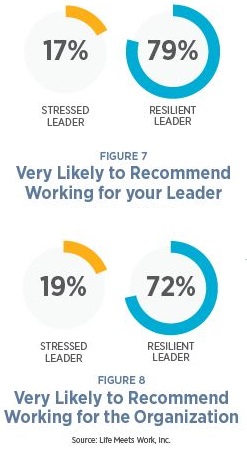Your employees can be overloaded on training, exposed to more information than they can absorb — especially if they are stressed or burned out. Too much of a good thing can be a real problem.
For people in corporate leadership roles, many forces align to keep them in a state of perpetual overwhelm. Early career and middle managers must satisfy the demands of more senior leaders while handling the frustrations of their subordinates.
Millennial leaders especially are also trying to get the most out of their personal and family lives, keeping up with trends on health, childcare, and personal fulfillment. Not to mention the demand to live stream their accomplishments on social media so everyone can know just how on top of things they are!
Leaders must manage their stress
 In our latest survey of college-educated employees, the importance of a leader’s ability to manage stress was very clear. It was one of the top three competencies for predicting whether an employee of any generation would recommend working for their leader, and number one for the Gen Z employees in our sample. Unfortunately, only about half (55%) of respondents agree their leader was effective or very effective at managing stressful situations.
In our latest survey of college-educated employees, the importance of a leader’s ability to manage stress was very clear. It was one of the top three competencies for predicting whether an employee of any generation would recommend working for their leader, and number one for the Gen Z employees in our sample. Unfortunately, only about half (55%) of respondents agree their leader was effective or very effective at managing stressful situations.
Too stressed to learn
Too many organizations try to help leaders by providing programs that offer even more information, more techniques, and more procedures to be a better leader. Yet, no matter the quality of that content, if leaders are stressed or burned out, they can’t actually learn or apply all of those expensive leadership lessons.
Research has long shown that stress impedes the ability to reflect, learn, and adapt to new information and situations. If leaders are overwhelmed and stressed, they will absorb only a fraction of what they are presented and apply even less (especially when they must convince their coworkers to go along with new ideas). Ultimately, teaching leadership competencies to leaders while they are too stressed to absorb and implement the content is worth little.
Furthermore, studies are showing that the old stand and deliver lecture style is ineffective. Undergraduate students in classes with traditional lectures are 1.5 times more likely to fail than students in classes that use more stimulating, active learning methods. Many corporate training programs use traditional methods with similar results.
Stress proofing your training
To be successful, corporate managers need more than training on the next great leadership philosophy. They need help being a fuller person who can manage the stress of a constantly changing workplace. Organizations interested in stepping up their leadership programs need to include more emphasis on wellbeing, and they need to modernize how that content is delivered. Some upgrades that need to be introduced are:
- More repetition: Stress impairs recall and pushes people to fall back on habit. That is why the military conducts frequent drills with leaders and soldiers. Repetition makes learning stress proof. Build your learning programs to revisit ideas and concepts at several points throughout the year so the training is more likely to be used back in the stressful real world.
- Encourage peer accountability: If you have repeated sessions with the same people, you create opportunities for internal networking. Paired with deliberate support for ongoing contact (such as team projects or small competitions), you can create cohorts of leaders who hold one another accountable for living up to their training even in the face of daily stressors.
- Use stress boosters: Stress isn’t all bad. In small doses right before a learning experience, it can actually focus attention. Some leaders — especially those who say they “thrive on stress” — need the emotional boost to engage with a learning experience. Of course, it’s not easy to give just a little work stress because people get stuck worrying about the office. Instead, use light physical activity to trigger a rush of adrenaline without the workplace worries. Participants will be energized and attentive without also being worried.
- Create stress buffer zones: On the other hand, too much stress 30 minutes or more before training impairs learning. So inserting a training session in the middle of a stressful work day can be a waste of effort. The stress of the morning will impede their learning. Complex learning, such as leadership training, requires a real separation from the daily stress. Retreats are valued learning environments for precisely this reason. However, if you can’t take people away for their training, make sure the training takes place at the start of the day so it doesn’t get disrupted by a crazy morning.
- Disconnect: Many leaders, especially those new to management, are still learning the fine arts of delegating and prioritizing. Unable to let something sit or allow a subordinate to handle it, they cling to their cellphones and their stress like a life raft. Instead of letting stress pursue them into the room, follow a different path. Instruct participants to put up an away message referring callers to a delegate for the day, because they will be shutting off their cellphones at the start of the session. If there’s a real emergency the delegate can call an onsite assistant who can pull the appropriate person out of the training. That way they can focus on the training and still be reachable for true emergencies, without constantly checking email.
- Limit access to caffeine and sugar: Both sugar and caffeine are often abused to maintain constant energy rather than allowing a participant a restorative break. Both substances can have adverse effects on the ability to manage stress and wellbeing, so it stands to reason that training sessions should help model better nutrition. Serve fruit, yogurt and other healthy food instead of carbs. Since removing caffeine can cause withdrawal symptoms, such as headaches, limiting coffee and colas is better than avoiding them. Consider offering caffeine only at the start of the day and use smaller cups to help participants reduce their intake.
- Add meditation moments: Instead of trying to recover energy through high calorie snacks, teach leaders to stop and breathe. Your willingness to spend precious training time on real breaks (remember their cellphones are turned off) can help leaders practice finding stillness in the chaos of everyday life. Alternatively, people can pursue more active meditations where they take walks or bike rides, or engage in other mindful activities that reenergize them for additional learning.
These are just a few ways that training can be more stress proof and provide learning experiences that have real effects on leaders and their organizations. Our women’s leadership experience, which follows these stress-resilient principles, has had great success. For example, one large accounting firm saw turnover among participants drop from 28% to 5% over a 12-month period. We believe the effectiveness of our methods lies in both the content and the stress-resilient delivery method.
Leaders are how an organization connects to its employees, shares information, and drives the culture forward. So, like any tool,we are tempted to pack them full of skills to do all that we can imagine demanding of them, despite the ever-diminishing returns. However, if we make sure that we are expanding their capacity to manage their stress and stay engaged with their work, there is so much more that they, and the people they lead, can accomplish.
